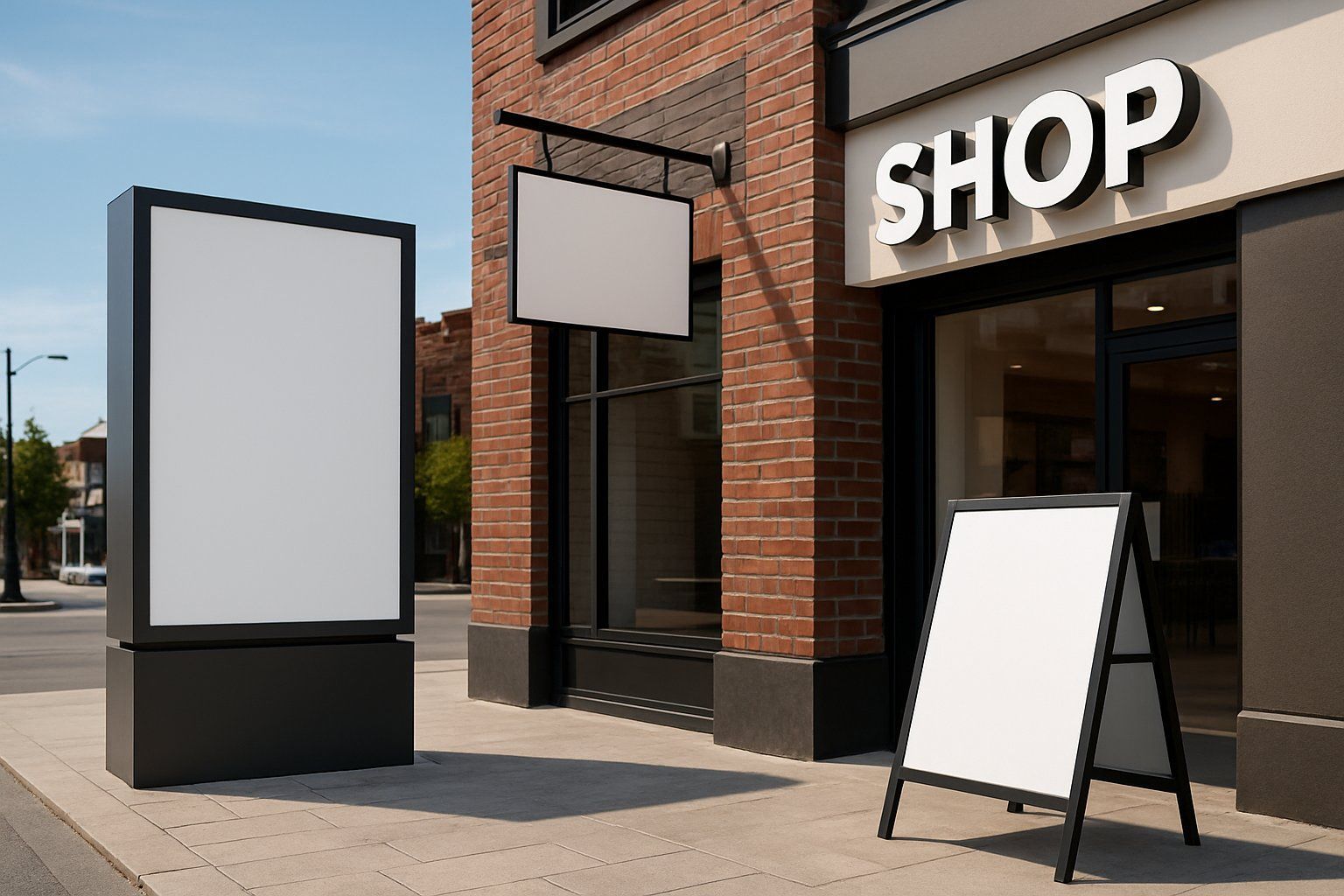Interior business signs play a key role in shaping customer experience. Well-designed signage can guide, inform, and create a welcoming atmosphere for customers.
When people enter a space, clear signs help them navigate easily and understand what to expect, which enhances their overall satisfaction.
Different types of businesses can benefit from tailored signage solutions. For instance, retail stores use signs to highlight promotions, while restaurants might showcase menus.
Thoughtful design and placement of these signs not only attract attention but also influence customer behavior.
Accessibility is another important aspect of interior signage. Effective signs cater to all customers, making spaces more inviting.
By focusing on these areas, businesses can improve their customer experience and foster loyalty.
The Role of Interior Signage in Customer Experience
Interior signage plays a crucial role in shaping customer experiences in various settings. Effective signage helps create positive impressions, guides navigation, and strengthens brand identity.
Each of these elements contributes to overall customer satisfaction and engagement.
Creating a Positive First Impression
First impressions matter significantly in any business. High-quality interior signage reflects professionalism and attention to detail.
Thoughtfully designed signs can create a welcoming atmosphere that draws customers in.
By using inviting colors and clear messaging, businesses can instantly communicate their values. This approach enhances the shopping experience from the moment customers enter.
Signage that aligns with the overall decor also reinforces a positive feeling, making customers feel comfortable and valued.
Facilitating Navigation and Wayfinding
Navigating a space can be challenging without clear signs. Interior wayfinding signs and directional markers help customers effortlessly find their way.
These signs reduce confusion and frustration, leading to a smoother experience.
Effective navigation aids include arrows, maps, and area labels. Such tools support a seamless flow throughout the space.
Customers appreciate when they can easily locate products or services, enhancing their satisfaction and encouraging them to return.
Enhancing Brand Identity and Recognition
Strong brand identity is essential for businesses to stand out. Interior signage is a vital tool for reinforcing branding through consistent visual elements.
Signs should include logos, colors, and fonts that align with the company’s overall brand identity.
When signage is designed well, it increases brand recognition. Customers associate the environment with the brand’s values and messages.
This consistent branding helps build trust and loyalty over time, making customers feel more connected to the business.
Signage Solutions for Various Business Needs
Businesses can use signage solutions to meet different needs. These signs can ensure safety, improve visibility for products, and create interactive experiences for customers.
Ensuring Safety and Compliance
Safety signs are essential in any business. They inform customers and employees about potential hazards.
- Warning Signs
: These alert people to risks, like wet floors or low ceilings.
- Regulatory Signs
: These signs help comply with local laws and regulations, such as exit signs and fire escape routes.
Clear and visible safety signs help create a safe environment. They can reduce accidents and ensure customers feel secure.
Businesses should place safety signs in high-traffic areas to ensure everyone sees them.
Improving Product Visibility and Promotions
Product visibility is key in engaging customers. Signage solutions can increase awareness of products and promotions effectively.
- Point-of-Sale Displays
: These highlight special offers right at the checkout.
- Shelf Tags
: Tags can show prices and details, making products easy to find.
Promotional signs catch attention and encourage purchases. Using dynamic content can make promotions even more appealing.
For instance, businesses can update signs in real-time to feature limited-time offers, making them more engaging.
Incorporating Interactive Elements
Interactive signs enhance customer experience by making it engaging. They can provide information and capture customer interest.
- QR Codes
: Customers can scan these codes with their phones to access more information or exclusive offers.
- Touch Screen Displays
: These allow users to browse products or services while in-store.
Interactive elements promote engagement and can lead to higher sales. They provide real-time updates, helping customers stay informed about new arrivals or current promotions.
Incorporating these features can help businesses stand out in a competitive market.
The Impact of Signage Design on Customer Behavior
Signage design plays a key role in how customers experience a business. Effective signage influences customer behavior, enhances service interactions, and can improve overall satisfaction.
Creating an Inviting Atmosphere
The design of interior signs can create a welcoming environment. Warm colors
and friendly fonts
can set a positive tone. This invites customers to explore and spend more time in the space.
Visual appeal
is crucial. Eye-catching designs and clear messages can draw customers in.
When customers feel comfortable, they are more likely to engage with products and services.
Furthermore, signs that reflect the brand’s identity help customers connect emotionally. This connection can lead to increased loyalty and return visits.
Optimizing Sign Placement for Maximum Effect
The location of signs is just as important as their design. Strategic placement
helps guide customer flow throughout the space. Signs should be easy to find and read.
For example, placing directional signs near entrances directs customers to key areas. Signs in high-traffic spots can influence decisions, encouraging purchases or inquiries.
Consistent sign positioning aids navigation and reduces confusion. Clear pathways lead to a better customer experience.
This careful arrangement also highlights promotions or new arrivals effectively.
Leveraging Digital Signage for Engagement
Digital signage offers dynamic content that can engage customers more effectively than traditional signs. Moving images or changing messages attract attention and can convey information quickly.
Businesses can use digital displays to highlight special promotions
or relevant news. This real-time data keeps customers informed and interested.
Moreover, interactive digital signs can create a personal experience. Customers can touch screens to learn more about products.
This interaction boosts engagement and encourages customer exploration, enhancing their overall experience.
Accessibility and Inclusivity in Interior Signage
Effective interior signage must cater to a diverse range of customers. This includes prioritizing readability for all and ensuring signs can adapt to various needs. Attention to these factors plays a crucial role in enhancing customer experience, brand consistency, and navigation throughout the space.
Designing for Readability and Navigation
Signage should be easy to read from a distance. Clear fonts and adequate contrast between text and background are essential.
Using sans-serif fonts
is often recommended for better legibility.
- Signage should follow guidelines like a minimum font size of 40 points for main areas.
- High contrast colors help those with visual impairments understand the signs easily.
- Avoiding cluttered designs allows quick comprehension and easier navigation.
Wayfinding elements should guide individuals smoothly through the space, reducing confusion. Clear directional arrows and simple language ensure customers can find their way without frustration.
Assuring Versatility and Adaptability
Interior signage should accommodate various customer needs and ever-changing information. Signs must be flexible for different settings, such as events or special promotions.
- Using removable or interchangeable panels allows businesses to update messages quickly.
- Incorporating tactile elements, such as braille, ensures inclusivity for those who are blind or visually impaired.
Additionally, signage solutions should cater to different languages to support diverse customer bases.
Designing signs to be modular can enhance versatility and maintain brand consistency.
By ensuring that signage is adaptive, businesses can improve overall accessibility and customer satisfaction.
Measuring the Efficacy of Interior Business Signs
Understanding how well interior business signs work can help improve the customer experience. By focusing on customer satisfaction and analyzing how signs influence shopping behavior, businesses can make informed decisions about their signage.
Evaluating Customer Satisfaction and Feedback
Collecting customer feedback is crucial for assessing the impact of signage. Surveys and comment cards can be used to gather opinions about sign clarity, placement, and effectiveness.
Businesses can ask specific questions like:
- Are signs easy to read?
- Did the signs help you find what you needed?
- How did the signs make you feel about the store?
This feedback directly informs businesses about customer experiences.
Positive remarks can show that signage is effectively enhancing satisfaction, while negative comments can reveal areas needing improvement.
Analyzing the Influence on Shopping Experience
Interior business signs play a significant role in defining a shopper’s journey. They guide customer behavior and help in making decisions.
Effective signage can prompt customers to explore more, leading to increased engagement and sales.
Key factors to consider include:
- Sign Clarity:
Clear signs help customers navigate the store easily.
- Emotional Impact:
Well-designed signs can create a welcoming atmosphere.
- Information Relevance:
Signs that provide valuable information can enhance the shopping experience.
By measuring how signage influences customer interaction, businesses can better tailor their environment to promote positive experiences.
How does the integration of technology in signs, like digital displays, affect customer interaction?
Digital displays can provide real-time information and dynamic content. They also allow for quick updates on promotions or events, making engagement more interactive.
Technology in signage can capture customers’ attention and enhance their overall experience.…












